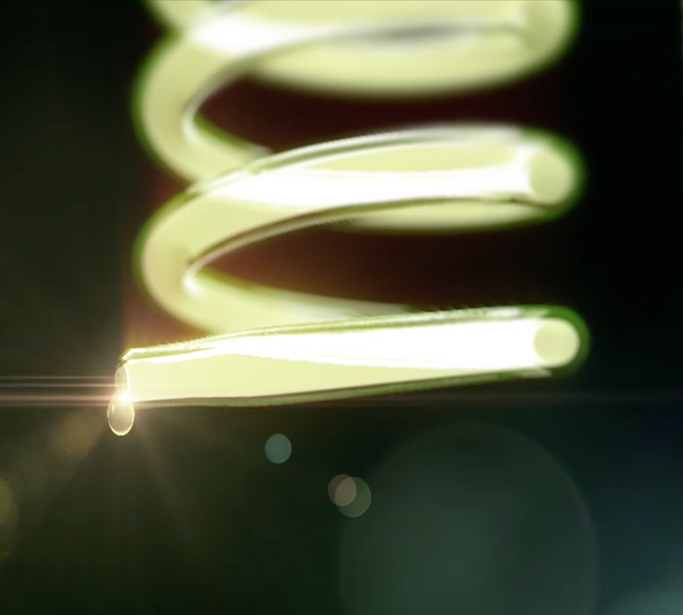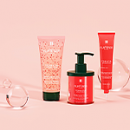Innovation and the science of hair
Discover the life cycle of hair and how the innovative active ingredients in René Furterer products improve the health and beauty of your hair.
LEARN TO BETTER UNDERSTAND YOUR SCALP AND HAIR
Scalp
The scalp has a protective layer of tissue on the surface, the epidermis, and a nourishing supportive layer of tissue underneath, the dermis, which contains multiple blood vessels where the root of the hair (the follicle) develops an "exchange zone" (dermal papilla) for extracting the vital energy for the hair. Next to the root is a sebaceous gland which secrets sebum to coat the entire length of the hair and protect it.
Hair
The visible part of the hair, the shaft, is made of three layers:
1. External layer (cuticle) formed of protective overlapping scales.
2. Middle layer (cortex) made of keratin fibers grouped together in spindle-like shapes. This layer contains the pigments responsible for the hair's natural color.
3. Inner layer (medulla).
THE HAIR LIFE CYCLE
Our hair is constantly renewing itself. A single hair emerges, grows, then falls out, as part of a hair cycle that repeats itself about 25 times during our lifetime and occurs in three stages:
1. The anagen phase, or growth phase. This lasts about 4 years in men and 6 years in women. Under normal conditions, about 90% of our hairs are in the anagen phase. During this phase, the vascular network that supplies the hair root is particularly well-developed around the follicle.
2. The catagen phase, or rest phase, which is fairly brief (1-3 months), during which the hair follicle becomes inactive. The matrix dies and although the hair does not grow any more, it remains rooted in the follicle.
3. The telogen phase, when the hair falls out. The hair is shed and replaced by another hair, whereby a new anagen phase begins. This period of renewal lasts approximately 3 months and explains why we normally lose around 100 hairs every day.
THERE ARE 2 TYPES OF HAIR LOSS
GRADUAL HAIR LOSS
This is caused by a reduced anagen (growth) phase, due to a gradual degeneration of the hair follicles. Each cycle becomes shorter than the one before. Finally, the follicle wears out completely, is reabsorbed, then disappears. The succession of 20-25 hair cycles, which ought to last a lifetime, ends sooner than expected.
In order to fight this type of hair loss, you must PROLONG THE LIFE OF THE HAIR.
SUDDEN HAIR LOSS
This is caused by a large number of hair follicles entering the telogen (shedding) phase early.
To treat this type of hair loss, you need to QUICKLY REACTIVATE HAIR GROWTH by triggering a new hair cycle.
WHAT CAUSES THIS HAIR LOSS?

POOR CIRCULATION
Blood flow to the scalp is essential for well-balanced hair growth. The micro-circulatory system is what ensures the hair follicle receives the optimal supply of all the elements needed for good hair growth: vitamins (in particular B5, B6, and B8,) trace elements, oxygen, energy (vitamin B3, arginine, etc.,) and amino acids (arginine, methionine, cysteine, etc.) Poor micro-circulation makes hair loss worse.
PHYPERSEBORRHEA
A hydrolipidic film made of sebum and sweat protects the surface of the scalp and hair. The sebum secretion is regulated by the hormone testosterone. Too much of this hormone causes over-production of sebum which can make hair loss worse.
RIGIDIFICATION AND INFLAMMATION OF THE DERMIS
A healthy scalp contains hair bulbs anchored within the dermis, which acts like a protective cocoon. The composition of the dermis (elastin, collagen) and its elasticity are key to ensuring optimal hair growth. If the dermis becomes rigid or inflamed, this can make hair loss worse.
THE CAUSES OF GRADUAL HAIR LOSS
POOR CIRCULATION
Blood flow to the scalp is essential for well-balanced hair growth. The micro-circulatory system is what ensures the hair follicle receives the optimal supply of all the elements needed for good hair growth: vitamins (in particular B5, B6, and B8,) trace elements, oxygen, energy (vitamin B3, arginine, etc.,) and amino acids (arginine, methionine, cysteine, etc.) Poor micro-circulation makes hair loss worse.
HYPERSEBORRHEA
A hydrolipidic film made of sebum and sweat protects the surface of the scalp and hair. The sebum secretion is regulated by the hormone testosterone. Too much of this hormone causes over-production of sebum which can make hair loss worse.
RIGIDIFICATION AND INFLAMMATION OF THE DERMIS
A healthy scalp contains hair bulbs anchored within the dermis, which acts like a protective cocoon. The composition of the dermis (elastin, collagen) and its elasticity are key to ensuring optimal hair growth. If the dermis becomes rigid or inflamed, this can make hair loss worse.
THE CAUSES OF SUDDEN HAIR LOSS
POOR CIRCULATION
Growth factors are responsible for increasing the blood flow to the hair follicle. This function is essential to regulating hair growth. Poor circulation to the scalp means the hair bulb does not receive the nutrients it needs and results in hair loss.
NUTRITIONAL DEFICIENCY
A deficient blood supply limits the amount of nutrients, energy and trace elements that reach the hair, causing it to enter the telogen (shedding) phase too early.
RENÉ FURTERER HAIR INNOVATION
NATURAL PFAFFIA EXTRACT (REGISTERED PATENT*)
Native to the Amazon, Pfaffia, also known as Brazilian Ginseng, is undoubtedly the most well-known plant in traditional medicine. Thought to be an elixir of long life, Pfaffia strengthens the internal organs while calming the nervous system and suppressing anxiety. It brings vitality, dynamism and strength.
René Furterer uses the remarkable properties of natural Pfaffia extract to stimulate the microcirculation the hair bulb. Hair thus receives the nutrients and energy it needs for optimal growth.
*in France


HYDROLYZED CURBICIA EXTRACT (REGISTERED PATENT*)
Curbicia is obtained by hydrolyzing squash seeds, a unique process patented by René Furterer Laboratories, for three times greater antiseborrheic efficacy. It acts on the enzyme that transforms testosterone into DHT, the hormone that triggers sebum production, and binds to receptors on the sebaceous cells instead of DHT, preventing sebum production.
René Furterer uses Hydrolyzed Curbicia extract to regulate hyperseborrhea, since this excess sebum suffocates the hair. The hair bulb is now free to grow and the hair grows healthy and strong.
*in France
ATP: ACTIVE INGREDIENT INNOVATION
ATP, or Adenosine TriPhosphate, is an active ingredient that is produced naturally by the body. It is an essential source of energy because it is the only fuel that the cells can use directly. Researchers at René Furterer have discovered the incredible effects of ATP on the cells in the hair follicle.
ATP acts right at the heart of the follicle to help maintain the growth (anagen) phase of the hair.
SUITED FOR EVERY TYPE OF HAIR LOSS
ATP has different effects depending on the concentration at which the active ingredient is used:
1. Its triple action at the heart of the dermal papilla extends the life of the hair, making it a highly effective active ingredient against gradual hair loss.
2. It induces the anagen phase, which makes it possible to rapidly restart hair growth and marks it out as a highly effective active ingredient that is suitable for treating sudden hair loss.
This is why René Furterer has included this active ingredient in its two hair loss prevention treatments, at two different concentrations specifically adapted for each type of hair loss.
TO FIND OUT MORE
To find out more about hair loss and the effects of René Furterer care products:
- GRADUAL, HORMONAL, HEREDITARY HAIR LOSS (in men and women): DermatoMag - Gradual hair loss. Benefits of TRIPHASIC VHT ATP INTENSIF - Regenerating treatment for hair loss - September 2014
- SUDDEN HAIR LOSS (due to stress, diet, illness, after giving birth): DermatoMag - Sudden hair loss. Benefits of RF80 ATP ENERGIE Concentrated serum for hair loss - September 2015








